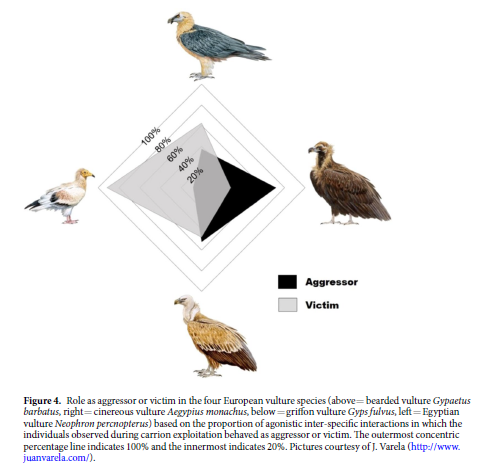
The authors of a new research article (Rubén Moreno-Opo, Ana Truijillano and Antoni Margalida) published in the Scientific Reports journal have demonstrated that larger vulture species and older individuals tend to be most dominant when groups of vultures are feeding at a carcass or other source of carrion.
Methods
The authors inspected video footage captured by remote cameras placed at four different carrion provisioning sites to record behavioural observations among the four European vulture species: Cinereous, Griffon, Bearded and Egyptian Vultures. They recorded the types of interactions instigated by or received by certain individuals at each feeding event, as well as the proportion of time that each interaction was successful.
Results
As carcasses are usually scarcely and unpredictably distributed in space and time, often termed as “pulsed resources”, vultures must compete fiercely to secure enough food to meet their energy requirements. As a result, vulture feeding events are often high-energy, frenzied occasions, with multiple individuals and species attempting to secure a good place at the carcass. These types of competitive interactions were termed as “agonistic” interactions in this paper. The three main types of recorded interactions were fights or attacks with the use of beaks, claws or wings; displacements without the use of beaks or claws; and stealing of food.
As expected, based on previous related research on other vulture communities in the Americas and Africa, the larger species and older individuals tended to dominate at carcasses. The larger and more powerful Cinereous Vultures were most aggressive, followed by Griffon Vultures (which also have the advantage of “power in numbers”), then Bearded Vultures, and finally the much smaller Egyptian Vultures which tended to be victims of aggressive interactions and very rarely the aggressors. Most of the interactions (65%) were among individuals of the same species, with fights/attacks being the most common, followed by displacements. Food stealing was very rare (only 5% of interactions) and was only recorded among the same species, mainly Griffon Vultures.

The highest success rates, and therefore the highest level of dominance, were achieved by adult and subadult Cinereous Vultures, followed by adult Griffon Vultures and juvenile Cinereous Vultures. The lowest success rates were achieved by adult and subadult Bearded Vultures and Egyptian Vultures. Interestingly, juvenile Bearded Vultures were placed above adults and subadults of the same species in the dominance hierarchy, possible because they feed at feeding sites more regularly because the food supply is more predictable, but also because juvenile Bearded Vultures are generally bolder, more social and have little experience of the risks of aggressive interactions.
At the lowest end of the “pecking order” were the Egyptian Vultures, which tended to stay on the edge of the feeding crowd, consuming small pieces of soft tissue discarded by the larger vultures. This might partially explain why Egyptian Vultures have a much more diverse diet compared to the other species, although they will frequently visit sites with a predictable and abundant carrion supply where they can meet at least some of their energy requirements. Similarly, the Bearded Vulture occupies a unique feeding niche among European vultures by specializing in consuming bones, perhaps explaining why older individuals with more experience avoided aggressive interactions, reducing the risk of injury.

This study provides a neat illustration of how the four different European vulture species have evolved different morphological and behavioural characteristics that enable them to coexist by exploiting different parts of carcasses. The results also have practical implications for conservation strategies. For example, the results showed that Griffon and Cinereous Vultures were more likely to monopolize carrion resources when they were limited, reducing the chances for Bearded and Egyptian Vultures to feed. This emphasizes the need for carefully designed supplementary feeding strategies such as those implemented for Egyptian Vultures in the LIFE Rupis project and throughout the range of Bearded Vulture reintroduction projects.

Source
Moreno-Opo, R., Trujillano, A. & Margalida, A. Larger size and older age confer competitive advantage: dominance hierarchy within European vulture guild. Sci Rep 10, 2430 (2020). https://doi.org/10.1038/s41598-020-59387-4
Sign up to our newsletter and never miss any vulture news!



